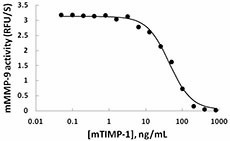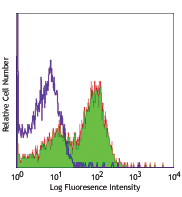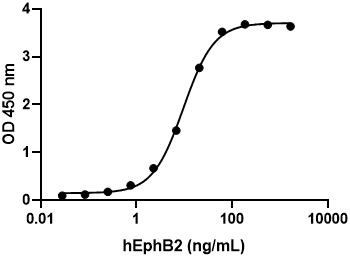- Regulatory Status
- RUO
- Other Names
- Erythroid-potentiating activity (EPA), Fibroblast collagenase inhibitor, Tissue inhibitor of metalloproteinases 1 (TIMP1)
- Ave. Rating
- Submit a Review
- Product Citations
- publications

-

Activated mouse MMP-9 (100 ng/mL) is inhibited by different concentrations of mouse TIMP-1.
| Cat # | Size | Price | Quantity Check Availability | Save | ||
|---|---|---|---|---|---|---|
| 593702 | 10 µg | $223 | ||||
TIMPs (tissue inhibitors of metalloproteinases) are endogenous inhibitors for MMPs (matrix metalloproteinases). The TIMPs consist of structurally and functionally distinct N- and C-terminal domains, each of which is stabilized by three disulfide bonds. The N-terminal domain binds to the active site of MMPs, inhibiting their proteolytic activities. The bidentate coordination of the zinc ion in the active site of an MMP by the N-terminal α-amino group and carbonyl group of the Cys residue in the "cysteine switch" is a key mechanism of inhibition with MMPs. The TIMP's C-terminal domain is known to bind hemopexin-like domain of pro-MMPs. TIMPs are broad-spectrum inhibitors of MMPs, but there are some differences in specificity among them. Mouse metalloproteinase inhibitor 1, TIMP-1, is more restricted in its inhibitory range than the other three TIMPs, having a relatively low affinity for the membrane-type MMPs, MMP-14, MMP-16, and MMP-24 as well as for MMP-19. Mouse TIMP-1 shares a 72% homology with its human counterpart. It is widely expressed in many mammalian tissues, notably in the reproductive organs. TIMP-1 is able to promote cell proliferation in a wide range of cell types and may also have an anti-apoptotic function. It has anti-angiogenic activity by preventing endothelial cell migration. CD63 has been identified as a receptor for TIMP-1. TIMP-1 binding to CD63 inhibits apoptosis and arrests cell growth. TIMP-1-null mice exhibit a number of alterations in processes associated with reproduction, steroidogenesis and impaired learning and memory. In addition, mice deficient in TIMP-1 exhibit enhanced MMP activity that would contribute to a reduction of atherosclerotic plaque size; neverthless, it promotes aneurysm formation.
Product DetailsProduct Details
- Source
- Mouse TIMP-1, amino acids (Cys27-Arg205) (Accession# NP_035723.2), is expressed with C-terminal TGHHHHHHHHGGQ tag in 293E cell line.
- Molecular Mass
- Predicted molecular mass of approximately 22 kD. The protein migrates at about 25 kD in DTT-reducing conditions and about 22 kD in non-reducing condition by SDS-PAGE. The N-terminal amino acid is Cys.
- Purity
- >90%, as determined by Coomassie stained SDS-PAGE.
- Formulation
- 0.22 µm filtered protein solution is in 20 mM Tris, 150 mM NaCl, pH 8.0.
- Endotoxin Level
- Less than 1.0 EU per µg of protein as determine by the LAL method.
- Concentration
- 10 µg size is bottled at 100 µg/mL.
- Storage & Handling
- Unopened vial can be stored between 2°C and 8°C for up to 2 weeks, at -20°C for up to six months, or at -70°C or colder until the expiration date. For maximum results, quick spin vial prior to opening. The protein can be aliquoted and stored at -20°C or colder. Stock solutions can also be prepared at 50 - 100 µg/mL in appropriate sterile buffer, carrier protein such as 0.2 - 1% BSA or HSA can be added when preparing the stock solution. Aliquots can be stored between 2°C and 8°C for up to one week and stored at -20°C or colder for up to 3 months. Avoid repeated freeze/thaw cycles.
- Activity
- Mouse TIMP-1 inhibits the activity of activated mouse MMP-9 (100 ng/mL). The IC50 ≤ 90 ng/mL.
- Application
-
Bioassay
- Application Notes
-
BioLegend carrier-free recombinant proteins provided in liquid format are shipped on blue-ice. Our comparison testing data indicates that when handled and stored as recommended, the liquid format has equal or better stability and shelf-life compared to commercially available lyophilized proteins after reconstitution. Our liquid proteins are verified in-house to maintain activity after shipping on blue ice and are backed by our 100% satisfaction guarantee. If you have any concerns, contact us at tech@biolegend.com.
- Product Citations
-
Antigen Details
- Structure
- Monomer
- Distribution
-
It is widely expressed in mammalian tissues, notably in reproductive organs and skin.
- Function
- Angiogenesis, tissue remodeling, cancer metastasis, apoptosis.
- Ligand/Receptor
- CD63, MMPs, pro-MMP-9.
- Biology Area
- Angiogenesis, Apoptosis/Tumor Suppressors/Cell Death, Cell Adhesion, Cell Biology, Stem Cells
- Molecular Family
- Enzymes and Regulators
- Antigen References
-
1. Brew K and Nagase H. 2010. Biochim. Biophys. Acta. 1803:55.
2. Murphy G. 2011. Genome Biol. 12:233.
3. Bourboulia D and Stetler-Stevenson WG. 2010. Semin. Cancer Biol. 20:161.
4. Kim YS, et al. 2012. BMB Rep. 45:623. - Gene ID
- 21857 View all products for this Gene ID
- UniProt
- View information about TIMP-1 on UniProt.org
Related FAQs
- Why choose BioLegend recombinant proteins?
-
• Each lot of product is quality-tested for bioactivity as indicated on the data sheet.
• Greater than 95% Purity or higher, tested on every lot of product.
• 100% Satisfaction Guarantee for quality performance, stability, and consistency.
• Ready-to-use liquid format saves time and reduces challenges associated with reconstitution.
• Bulk and customization available. Contact us.
• Learn more about our Recombinant Proteins. - How does the activity of your recombinant proteins compare to competitors?
-
We quality control each and every lot of recombinant protein. Not only do we check its bioactivity, but we also compare it against other commercially available recombinant proteins. We make sure each recombinant protein’s activity is at least as good as or better than the competition’s. In order to provide you with the best possible product, we ensure that our testing process is rigorous and thorough. If you’re curious and eager to make the switch to BioLegend recombinants, contact your sales representative today!
- What is the specific activity or ED50 of my recombinant protein?
-
The specific activity range of the protein is indicated on the product datasheets. Because the exact activity values on a per unit basis can largely fluctuate depending on a number of factors, including the nature of the assay, cell density, age of cells/passage number, culture media used, and end user technique, the specific activity is best defined as a range and we guarantee the specific activity of all our lots will be within the range indicated on the datasheet. Please note this only applies to recombinants labeled for use in bioassays. ELISA standard recombinant proteins are not recommended for bioassay usage as they are not tested for these applications.
- Have your recombinants been tested for stability?
-
Our testing shows that the recombinant proteins are able to withstand room temperature for a week without losing activity. In addition the recombinant proteins were also found to withstand four cycles of freeze and thaw without losing activity.
- Does specific activity of a recombinant protein vary between lots?
-
Specific activity will vary for each lot and for the type of experiment that is done to validate it, but all passed lots will have activity within the established ED50 range for the product and we guarantee that our products will have lot-to-lot consistency. Please conduct an experiment-specific validation to find the optimal ED50 for your system.
- How do you convert activity as an ED50 in ng/ml to a specific activity in Units/mg?
-
Use formula Specific activity (Units/mg) = 10^6/ ED50 (ng/mL)

 Login/Register
Login/Register 














Follow Us